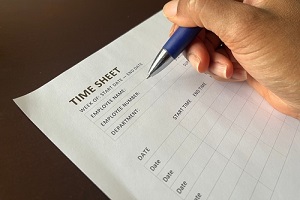 DCAA compliance stands as a cornerstone for businesses aiming to become government contractors. The Defense Contract Audit Agency (DCAA) performs contract audits for many federal agencies, primarily including the Department of Defense. Adhering to DCAA standards ensures smooth operations and avoids regulatory pitfalls.
DCAA compliance stands as a cornerstone for businesses aiming to become government contractors. The Defense Contract Audit Agency (DCAA) performs contract audits for many federal agencies, primarily including the Department of Defense. Adhering to DCAA standards ensures smooth operations and avoids regulatory pitfalls.
In this arena, effective DCAA compliant timekeeping software serves a central role. This software helps businesses meet guidelines and maintain a seamless workflow. By adopting the right tools and processes, companies can bolster their compliance position with federal rules and regulations.
Having the Right Setup
Electronic time cards have become a preferred choice for many businesses, offering efficiency, accuracy, and ease of use. Gone are the days of manual logs and handwritten entries. Electronic timecards bring precision to the forefront, reducing errors, and streamlining the timekeeping process.
On the other hand, many businesses rely on accounting systems to manage their finances. QuickBooks, a popular choice, manages a vast array of financial tasks.
When businesses integrate their timekeeping tools with QuickBooks and similar programs, they experience many benefits. This integration means data flows smoothly between systems, reducing manual data entry and potential errors.
The combined strength of electronic timecards and integrated accounting systems allows businesses to manage their timekeeping needs with greater efficiency. Knowing their timekeeping setup stands firm and reliable, they can then focus on their core operations.
Tracking Changes
Audit trails reinforce transparency for businesses. By maintaining this record, companies can see who made changes, when they were made, and what those changes were. It’s a clear roadmap of all activities, ensuring clarity and honesty in operations.
Without a keen eye on timesheet alterations after submission, businesses expose themselves to potential problems. Changes can lead to confusion, disputes, or even financial discrepancies.
If an employee were to adjust their hours without notice or reason, this action could cause billing issues or disrupt payroll calculations. Effectively monitoring these modifications serves as a protective measure, safeguarding businesses from unforeseen challenges.
In sum, an audit trail offers transparency, while closely watching timesheet changes defends against potential pitfalls. Both practices help establish a trustworthy and dependable system.
Establishing a Timekeeping Policy
 Every solid structure starts with a clear blueprint. For businesses, a well-documented timekeeping policy acts as this guiding document. This policy outlines the rules for recording time, gaining proper authorizations, and ensuring the accuracy of charge codes. It’s the foundation upon which reliable timekeeping rests.
Every solid structure starts with a clear blueprint. For businesses, a well-documented timekeeping policy acts as this guiding document. This policy outlines the rules for recording time, gaining proper authorizations, and ensuring the accuracy of charge codes. It’s the foundation upon which reliable timekeeping rests.
When employees have a clear understanding of the rules, confusion decreases. A detailed policy makes known what is expected and what is allowed. With this guide, employees know how to record their hours, who needs to approve their time, and how to categorize their tasks. The end result is fewer errors, smoother operations, and a happier workforce.
Furthermore, a strong policy does more than just guide actions; it sets the tone for the workplace. When everyone knows the rules and follows them, it fosters a culture of responsibility and trust. In a world filled with complexities, having clarity in a system as fundamental as timekeeping can bring immense benefits.
Implementing Policy and Controls
A written timekeeping policy is the first step, but the real value is visible when put into action. Training is the bridge between a written policy and its daily practice. By educating employees on the details and requirements of the policy, businesses ensure that all staff are on the same page.
Beyond training, controls serve as the safety nets of the system. They monitor activities, ensuring that the timekeeping rules are followed consistently. If an employee falls off of the rules, the controls provide sufficient notification, allowing for timely corrections. Together, effective training and robust controls create a timekeeping system that stands strong and serves its purpose well.
Syncing Timesheets and Software
In the digital age, efficiency often comes from smart connections. One shining example is software integration, especially between DCAA compliance compatible timekeeping software and accounting software systems.
When these systems are combined, managing compliance becomes more visible and less complicated. This automation reduces the chances of error, saves time, and streamlines tasks. Furthermore, automatic data synchronization offers several benefits:
- Ensures consistent information across platforms.
- Reduces/eliminates discrepancies or mismatches.
- Aids in faster decision-making with the updated financial data.
When performing month-end or year-end tasks, having synced data can make the process more efficient.
Partner with Diener & Associates for Your Timekeeping Needs
 DCAA compliance remains a significant focus for many businesses. By implementing the right timekeeping software and processes in place, companies can confidently meet these standards. However, it’s not just about having the tools; it’s about using them effectively.
DCAA compliance remains a significant focus for many businesses. By implementing the right timekeeping software and processes in place, companies can confidently meet these standards. However, it’s not just about having the tools; it’s about using them effectively.
Enlisting the experience of a CPA firm specializing in government contracting can ensure that your software implementation goes smoothly. Diener & Associates is a team of CPAs with extensive working knowledge of DCAA audits and related aspects of government contracting prepared to assist with implementing your software. Contact Diener & Associates today to learn more.
